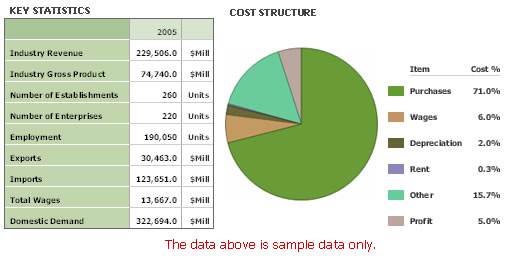Sawmills and Wood Preservationin USA
USA Market Research and Industry Report
5 November 2007
Industry Code : 32111
This industry comprises establishments primarily engaged in one or more of the following: (1) sawing dimension lumber, boards, beams, timber, poles, ties, shingles, shakes, siding, and wood chips from logs or bolts; (2) sawing round wood poles, pilings, and posts and treating them with preservatives; and (3) treating wood sawed, planed, or shaped in other establishments with creosote or other preservatives to prevent decay and to protect against fire and insects. Sawmills may plane the rough lumber that they make with a planning machine to achieve smoothness and uniformity of size. The US Sawmilling and Wood Preservation industry acquires its key raw materials (i.e. sawlogs and bolts) from logging companies and other ingredients such as resins and other chemicals from specialist manufacturers or wholesalers. These raw materials are combined to produce a range of sawn hardwood and softwood that is then sold to downstream wood product manufacturers (such as veneer, plywood and engineered wood product manufacturers) as well as the millwork industry. The finished wood products may also be sold to lumber wholesalers.
The major products and services in this industry are:
| - | Unpreserved sawnwood |
| - | Preserved sawnwood | |
The primary activities of this industry are:
| - | Sawing hardwood logs |
| - | Sawing softwood logs |
| - | Preserving lumber with chemicals and resins | |
IBISWorld research reports contain trend analysis, statistics, market size information, industry growth rates as well as market share of competitors.
Major market segments are identified and also those forces affecting demand and supply within the industry. Performance analysis includes emerging industry trends as well as recent results and performance of each key company. Drawing on the depth of information IBISWorld also provides 5 year forecasts for each industry.
Each comprehensive study also examines details such as the barriers to entry, operating cost structure, technology & systems and domestic & international markets. Tables and statistics include: Industry revenue, exports, imports, wages and number of companies in the industry, Industry growth and geographic regional data.
Each comprehensive study also examines details such as the barriers to entry, operating cost structure (including averages), technology & systems and domestic & international markets. Tables and statistics include: Industry revenue, exports, imports, wages and number of companies in the industry, Industry growth and geographic location.






